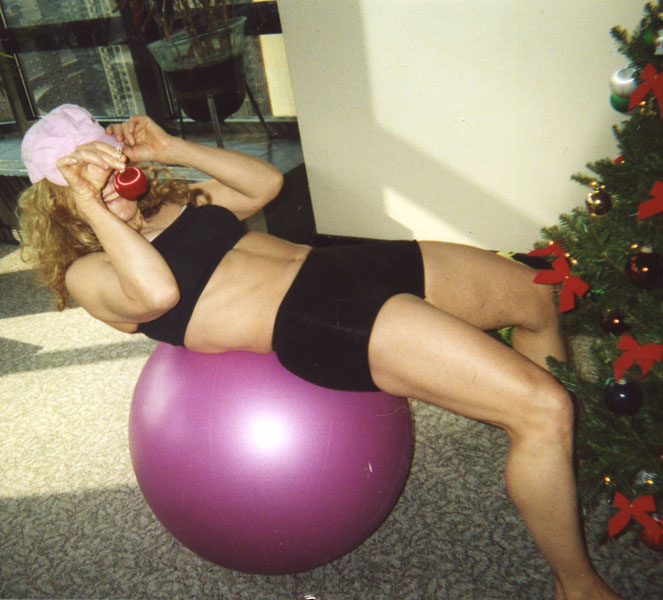
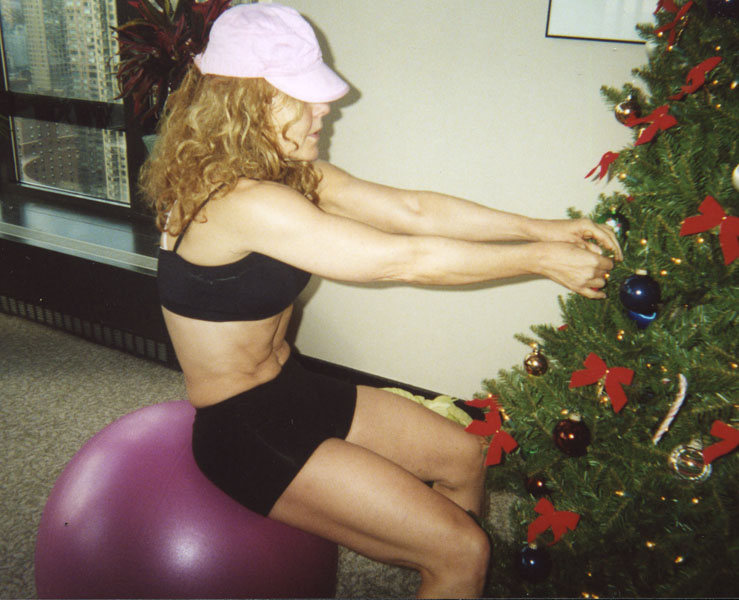
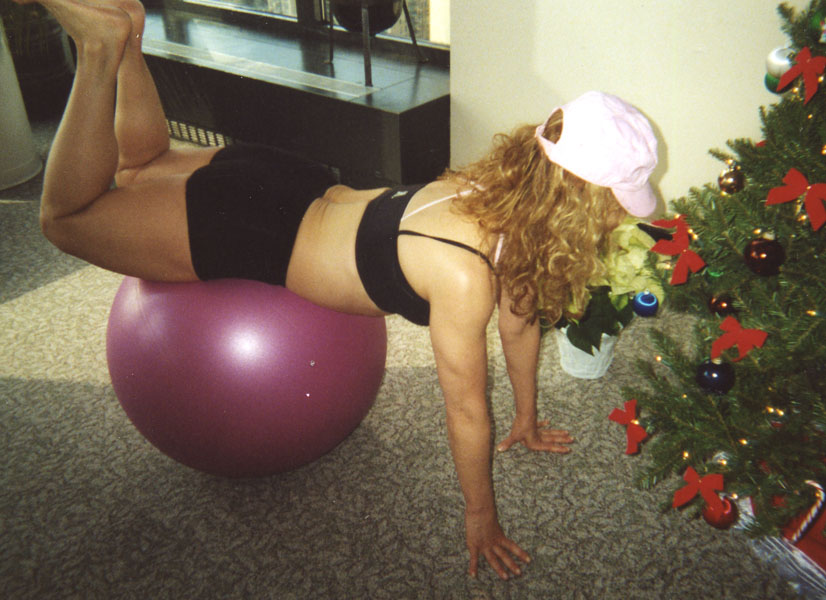



Part One: Knockout CardioCore with Aerobic-Gut-and-Butt™
Knockout Your Core centers your total body strengthening program at your core, with exercises for the abdominals, back, buttocks and chest, using various kinds of resistance, focusing on posture, rhythm and coordination with routines from Aerobic Gut and Butt™
You may think of your spine as a skeleton but it is a wondrous, fluid, live organism, more like a snake as it twists, turns, bends and arches. When it is injured, it is good to go back to basics but eventually you want to resume your constant, vigorous activities. Even older people can run, take ballet, lift heavy weights and climb mountains if they have the strength, flexibility, coordination and good sense to pace themselves and know their limits. So much of our lingering pain is psychosomatic, embued with the memory of what was, exacerbated by the fear of what might happen, we often don't realize it could disappear if we could just let go. Aerobic-Gut-and-Butt is a free flow, fluid version of core strengthening, not appropriate for Level I, but it will give you the strength, flexibility and coordination to do everything from belly dancing and love-making to having babies to getting ready for sports. Aerobic-Gut-and-Butt is a bit like interval training in that the sequences are sometimes switched and new modalities added as they are invented. However, it should be as fluid and non-stop as possible. The principle is to combine core work with cardiorespiratory training only up to 75% of maximal heart rate.
Equipment
You can use BOSU and Swiss balls, crunch on the ball or BOSU and punch on the bag, the body bar and the thigh squeezer, or even the mini-trampoline. If you are at a gym, you can do the regular ab machines peppered with cardio intervals to keep your heart rate up and burn fat. If you have no equipment, just use gravity or hold your baby or groceries.
Music
AGB requires Middle Eastern, Latin or any music that makes you think of wiggling your hips. The step and kick routines are for balance, not a workout, same with the punches. AGB is more of a boot camp where you keep moving but not as steadily as you do in KSSS. This means some plyo is good because it works the buttocks aerobically. Perhaps the trampoline goes here or just jumping on the floor. This is not a complex choreography class--it is dancey but simple. The feet could be worked, flexing and pointing.
Isolations
Head
Say yes up and down
Say no left and right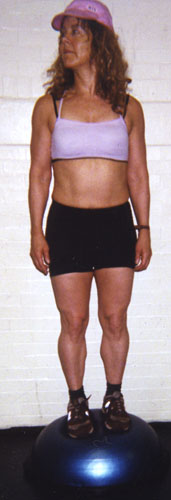
Do the pigeon forward and back
Ear to shoulder
Pendular swings
Shoulders
Forward, Up, Back and Down
Together and Tandem
Shimmy
Ribcage
Right Forward Left Back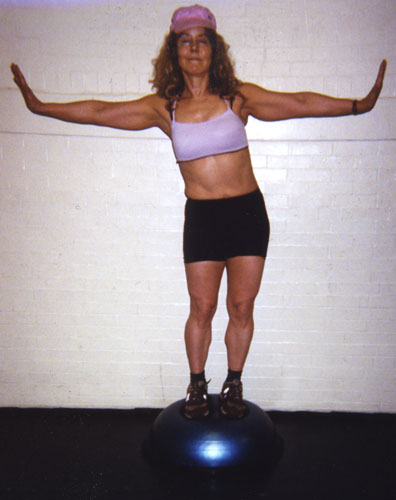
Circle clockwise and counterclockwise
Pelvis
Forwards/Backwards
Side to Side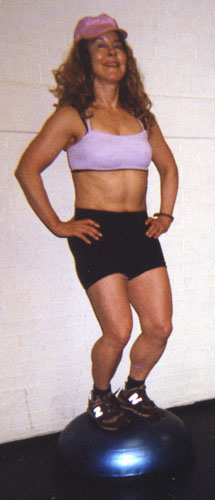
Figure Eights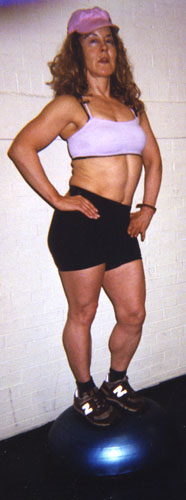
Shimmy and Squat
Body Rolls
Advanced students can combine complex combinations, isolating different parts of the torso: for example, sinuous vertical rib cage circles with fast earthquake pelvic shimmys, or fast shoulder shimmys with rib cage lifts and pelvic circles.
The purpose of these isolations is not only to begin moving aerobically but to increase your flexibility and coordination so that you use more of your core muscles. Often when people just do half sit-ups they don’t use as many muscles as they could. Another reason is to isolate the head from the pelvis. Keep your head cool and empty and your belly hot when working the abs.Levels II and III can do these isolations on the Bosu to activate all your core muscles. The Bosu is great for beginners who are afraid of falling off the larger Swiss ball. You can stand on it for balance, coordination and weight lifting, turn it over for a BAPS-type board to strengthen your feet and legs. The Swiss ball is better for bridges and lay-overs and full-range sit-ups. Experts are saying these balls should only be used for core training, not weight lifting. Too much mult-rep, endurance weight lifting weakens the muscles. But then it is good to balance on the Bosu and on one leg if it is part of the core program.
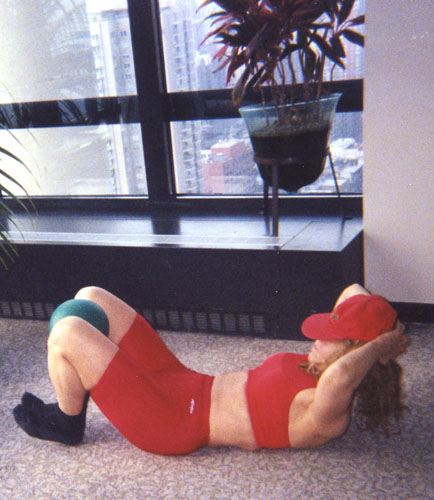 A basic half sit-up can include inner thighs and pelvic floor muscles as well as abs if you squeeze a ball or thigh squeezer or pillow between the knees.
A basic half sit-up can include inner thighs and pelvic floor muscles as well as abs if you squeeze a ball or thigh squeezer or pillow between the knees.  When you lift the thighs off the floor to target lower fibers of the abs make sure you exhale strongly to keep the abs as flat as possible to avoid overarching when the iliopsoas takes over.
When you lift the thighs off the floor to target lower fibers of the abs make sure you exhale strongly to keep the abs as flat as possible to avoid overarching when the iliopsoas takes over. 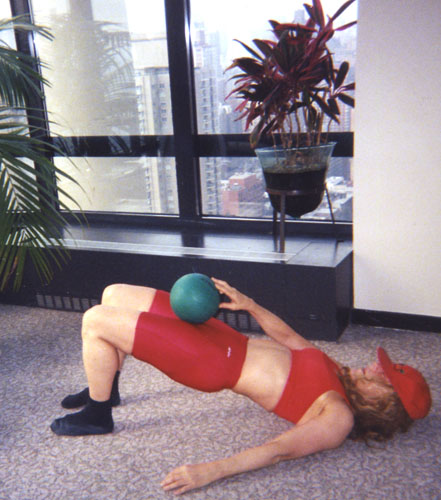 By placing an object over the groin you feel the buttocks more when you lift into a bridge to stretch the abs.
By placing an object over the groin you feel the buttocks more when you lift into a bridge to stretch the abs. 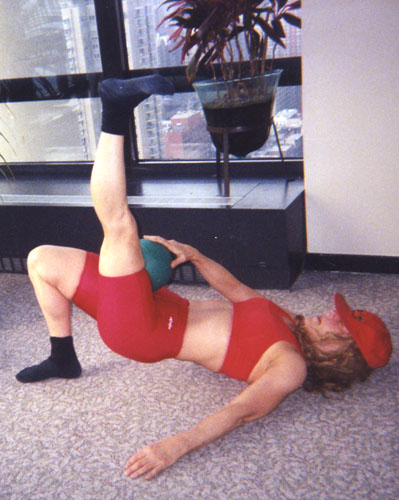 A more advanced version is to do single leg bridges. Keep the pelvis even and the lower abs contracted.
A more advanced version is to do single leg bridges. Keep the pelvis even and the lower abs contracted.  Spinal twists target the oblique muscles as you exhale back to center. If this hurts your back, keep you feet on the floor and don't go too far. If it is too easy, straighten your legs.
Spinal twists target the oblique muscles as you exhale back to center. If this hurts your back, keep you feet on the floor and don't go too far. If it is too easy, straighten your legs.
 Sit-ups can be fun especially if you do one for every ornament you put on the tree.
Sit-ups can be fun especially if you do one for every ornament you put on the tree.  This is the best way to avoid that eggnog gut during the holiday season!
This is the best way to avoid that eggnog gut during the holiday season!
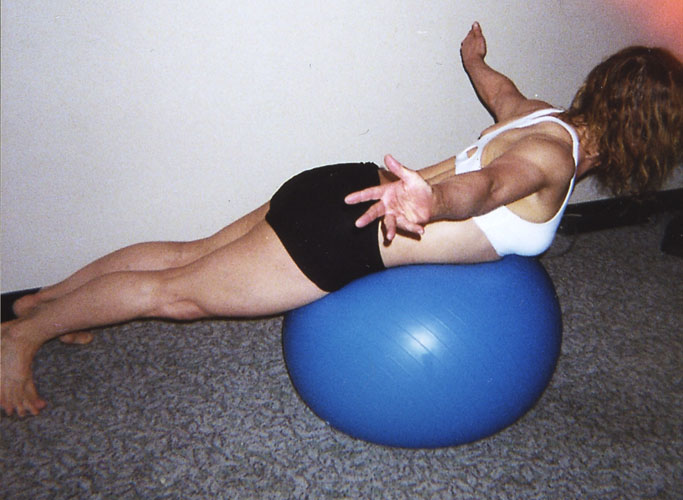 It is just as important to do extensor exercises for the back as it is to crunch. A beautiful, strong back will keep you standing straight; just doing crunches can wreck your posture. Remember gut and butt go together!
It is just as important to do extensor exercises for the back as it is to crunch. A beautiful, strong back will keep you standing straight; just doing crunches can wreck your posture. Remember gut and butt go together! 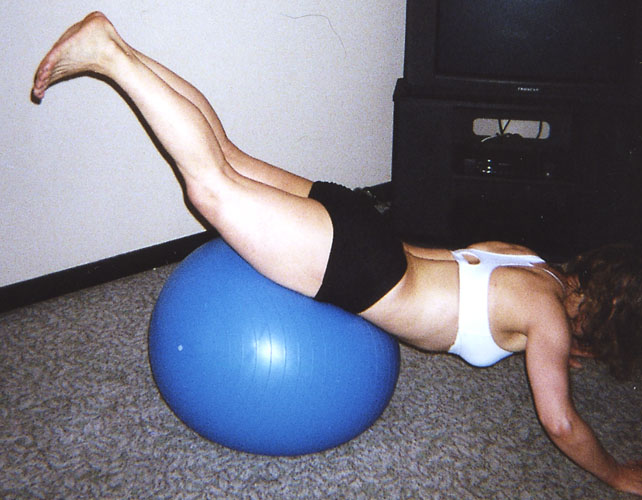
Level III can hold a medicine ball between the feet while extending the lower back and lifting the legs. 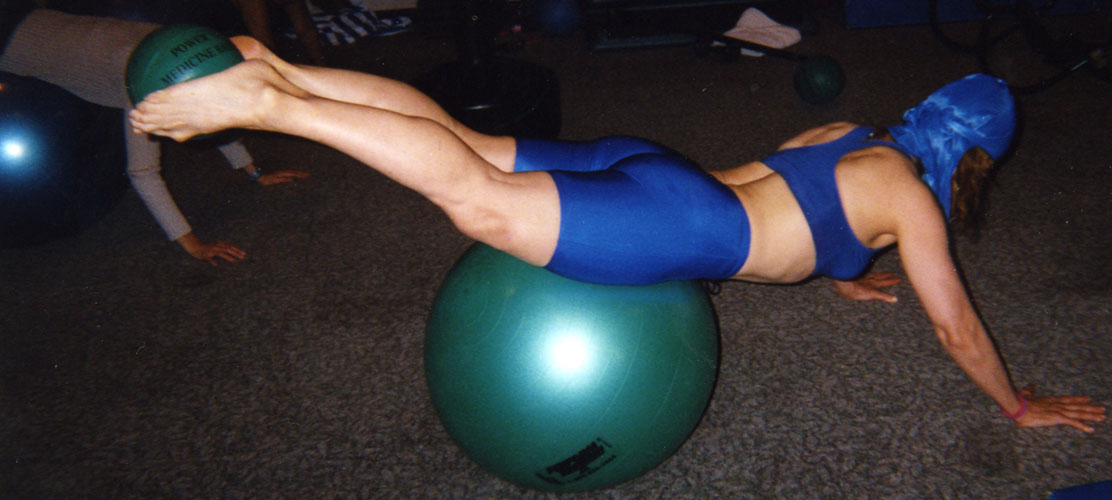
If you have problems hyperextending the spine or want to include buttocks and hamstrings together use the Swiss ball to intensify your bridge. Contract your pelvic floor and abdominals, exhale, deflate the balloon, and lift your tailbone off the floor as if your spine were the curled-up end of a toboggan.
To work the hamstrings, 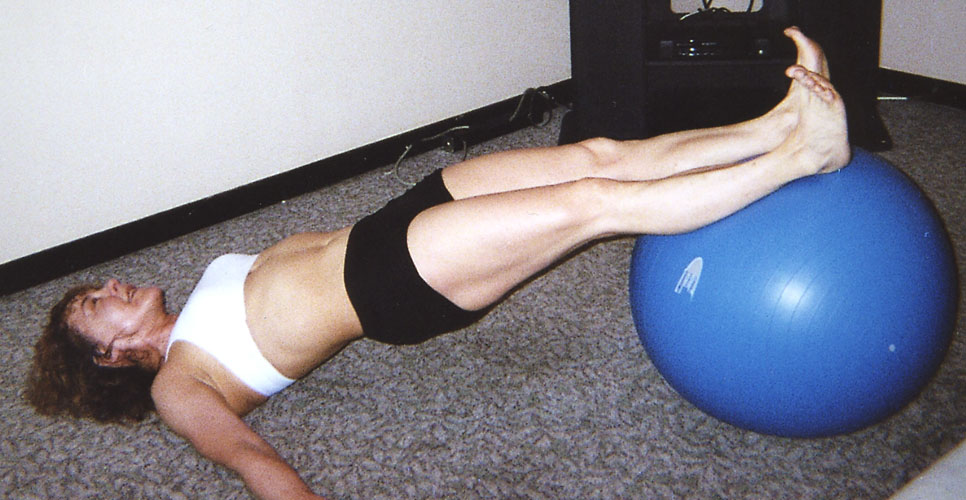 keep your pelvis high as you bend and straighten your legs.
keep your pelvis high as you bend and straighten your legs.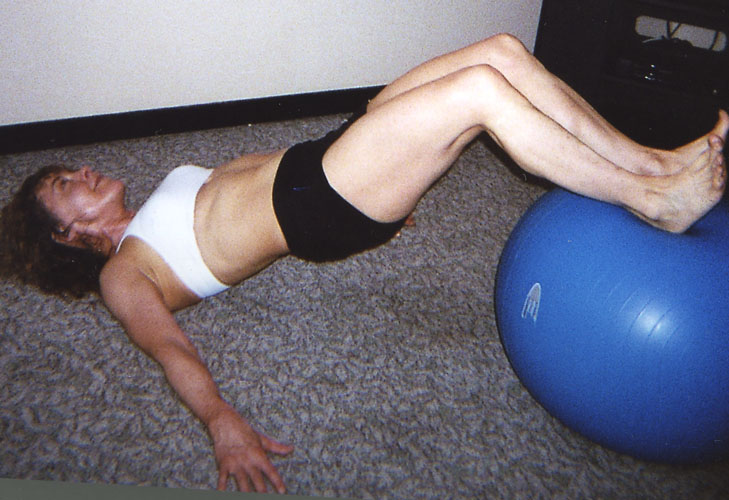
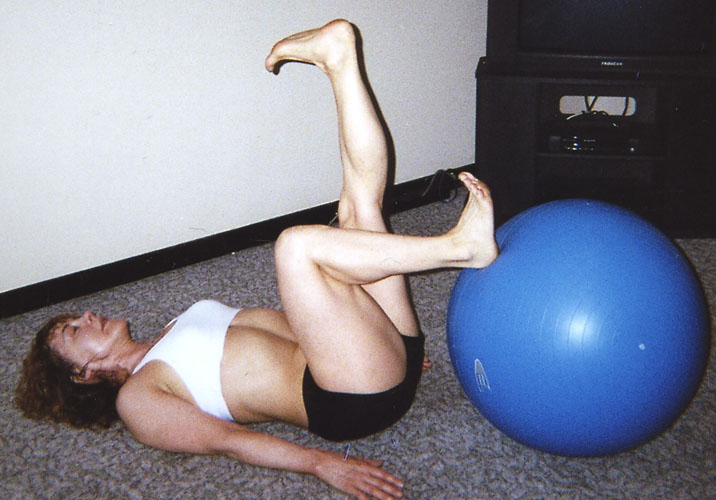 It is hard to lift and lower with one leg so dig your heel into the ball, contract your pelvic floor muscles and buttocks and slowly round the back, peeling each vertebra off the floor one at a time.
It is hard to lift and lower with one leg so dig your heel into the ball, contract your pelvic floor muscles and buttocks and slowly round the back, peeling each vertebra off the floor one at a time. 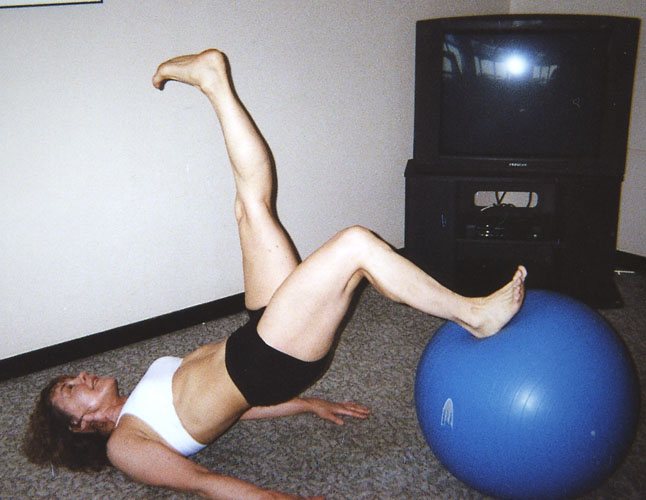 Squeeze the butt strongly and keep the pelvis even.
Squeeze the butt strongly and keep the pelvis even.
Adding Punches or Weights
To increase the difficulty, hold a weight across your chest, or a barbell or body bar with your arms straight behind your head. For more of a fight, put on boxing gloves and punch a bag as you come up.
The main thing to remember about crunches is that you should exhale and deflate, zip up a zipper or feel a magnet pulling the navel into the back but not the back into the floor. Don’t think of shortening your spine as you crunch. Crunches can be done in all positions on the Bosu.
Jabs and Abs 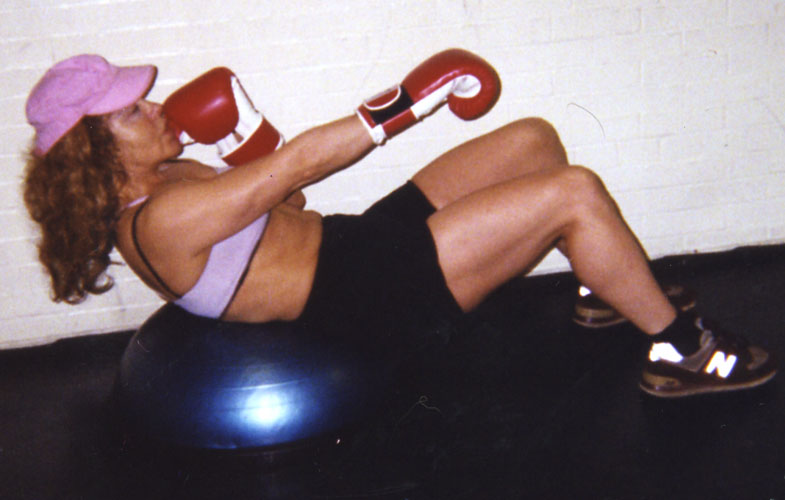 Boxers have iron abs so why not crunch and punch, just not right after lunch? Take a breather from hitting and kicking the bag, lie on a BOSU and hit a real or imaginary target.
Boxers have iron abs so why not crunch and punch, just not right after lunch? Take a breather from hitting and kicking the bag, lie on a BOSU and hit a real or imaginary target. 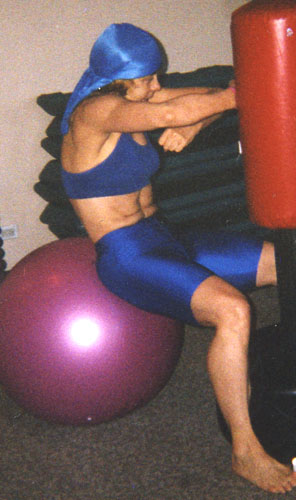 Front jabs, crosses, and hooks target different ab muscles.
Front jabs, crosses, and hooks target different ab muscles.
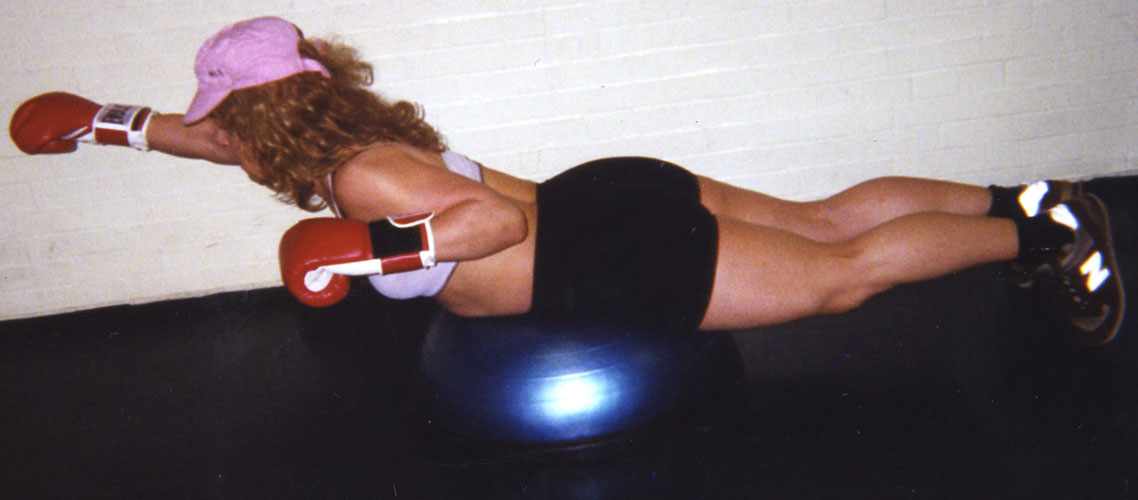 When you punch in back extension position,
When you punch in back extension position,
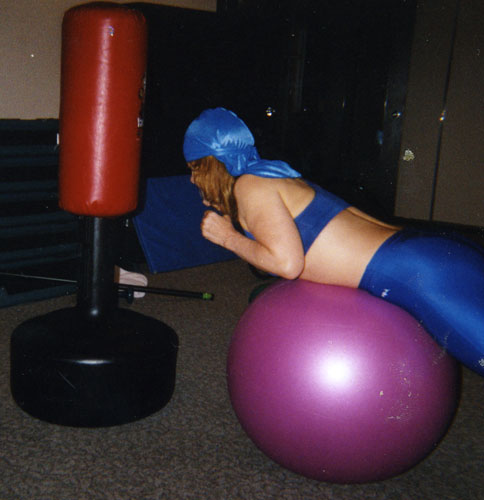
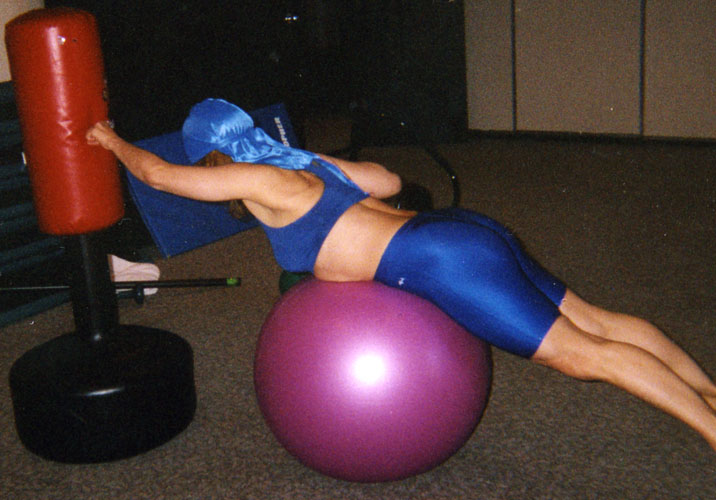
you target your lats, middle trapezius and rhomboids, and improve your skill at retracting in kickboxing.
Crunch and punch on your side to get rid of love handles. 
To get the spinal rotators, touch and twist.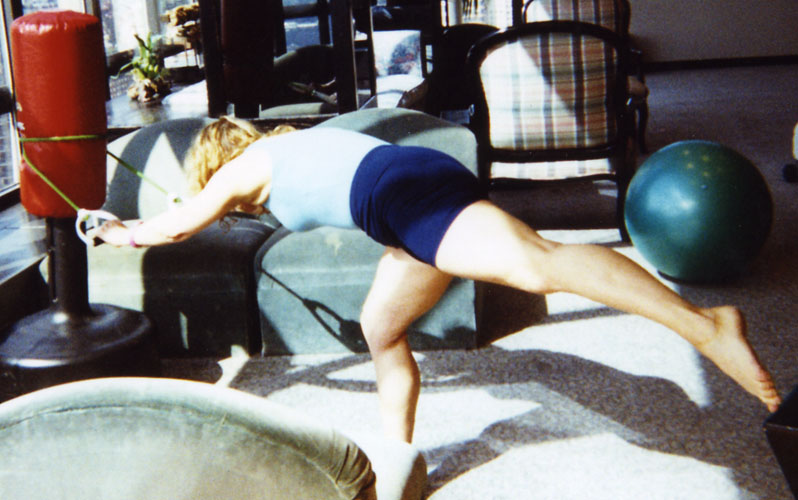
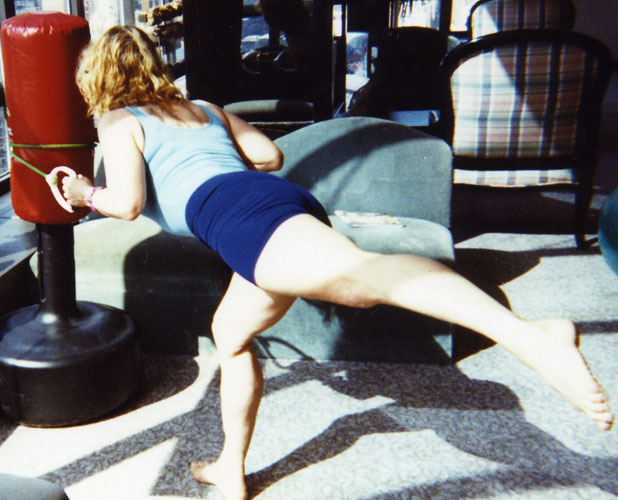
Attach a band to the bag to work your lats.
Chapter 03: Twist, Turn, and Yearn with the Ball and Bar
Wood choppers have powerful torsos. You can do the same kind of movements with a body bar without destroying trees.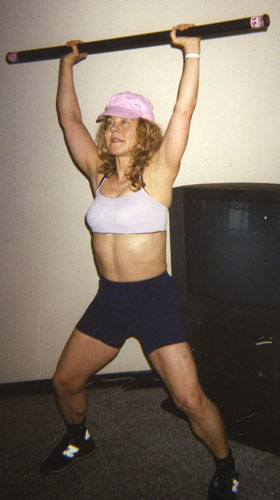 Exhale and contract abs powerfully. Make a deep sound if you like.
Exhale and contract abs powerfully. Make a deep sound if you like.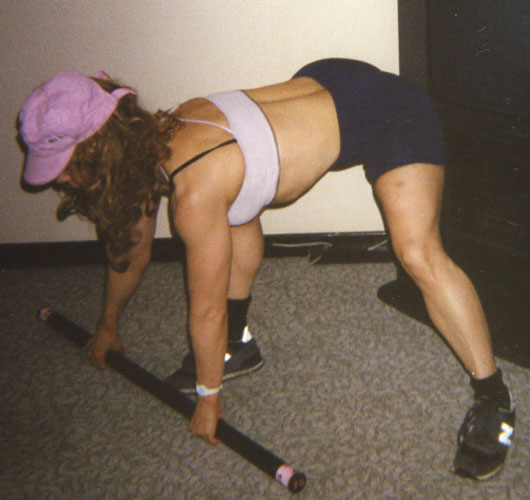 Keep your back straight in the deadlift position.
Keep your back straight in the deadlift position.  Don't rotate if you have a bad back; otherwise this is great for the entire core.
Don't rotate if you have a bad back; otherwise this is great for the entire core.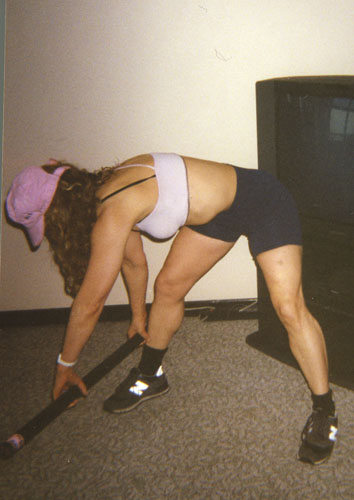 Change your grip on the bar the way you would holding an axe.
Change your grip on the bar the way you would holding an axe.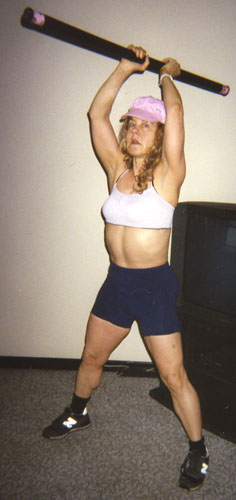 Then nail the chop with a "puke" quality.
Then nail the chop with a "puke" quality.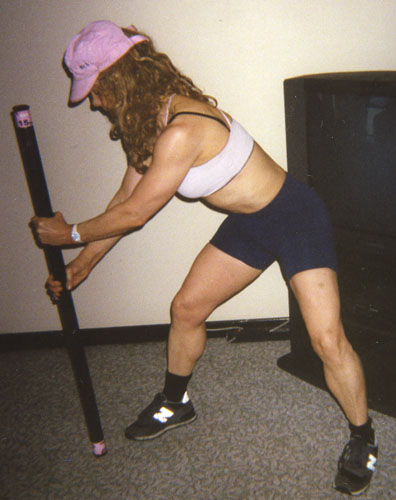 Do equal chops up, down, right, left, and rotary so you keep the muscles of your spine balanced.
Do equal chops up, down, right, left, and rotary so you keep the muscles of your spine balanced.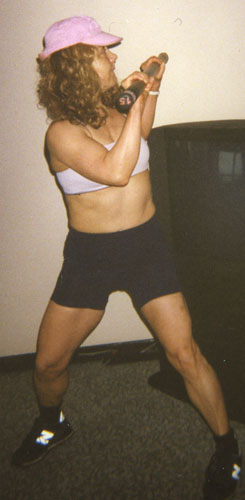
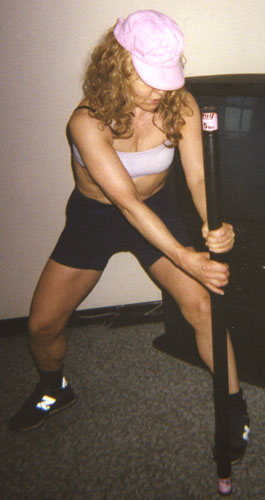 These chops should be done rhythmically so you feel a cardio-core workout.
These chops should be done rhythmically so you feel a cardio-core workout.
Laundromat
Wash
Wring
Spin
Circular abs are a great way to target the transversus abdominis and all the muscles in between. 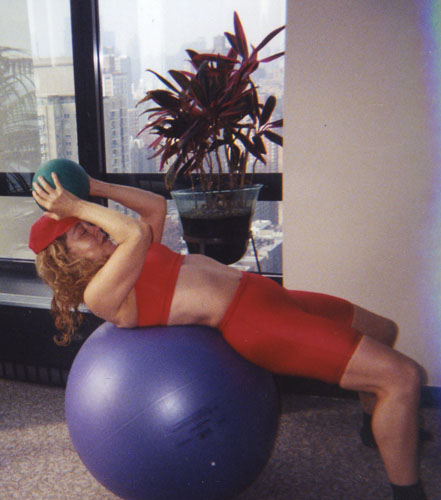 Imagine you are wringing out wet clothes,
Imagine you are wringing out wet clothes, 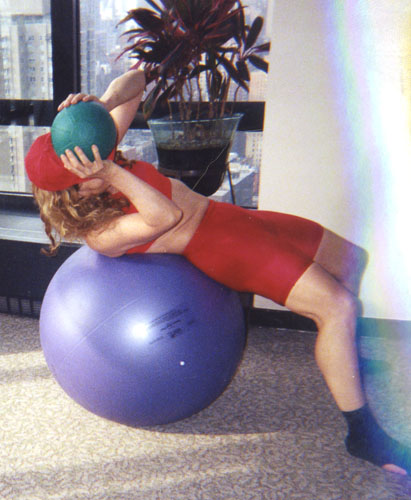 keep your head and neck relaxed, and as always, exhale as you flatten the abs.
keep your head and neck relaxed, and as always, exhale as you flatten the abs.
Try to do this at different tempos, slowly at first, and then quickly as you switch to the spin cycle.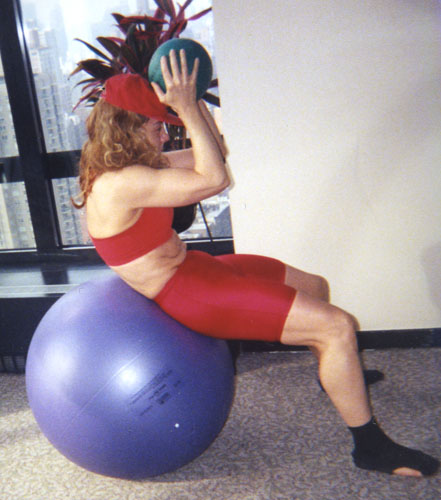
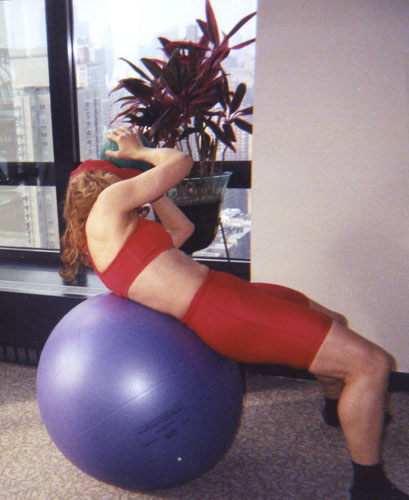 Do this with the body bar or a ball or a weight.
Do this with the body bar or a ball or a weight.
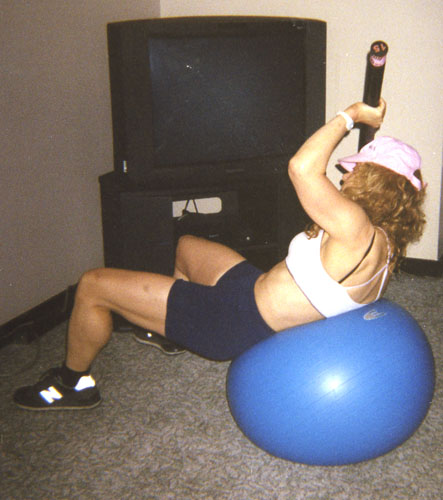
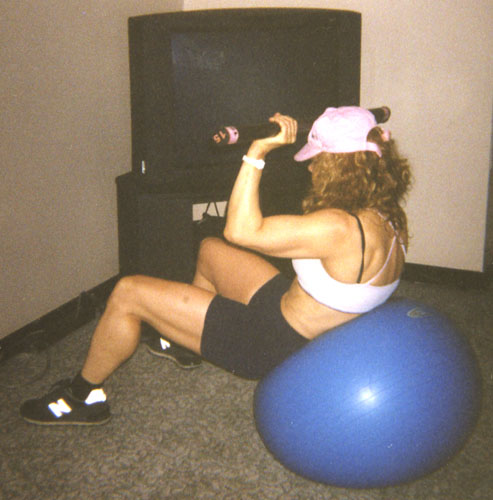 Remember to work the back muscles just as hard as the front.
Remember to work the back muscles just as hard as the front. 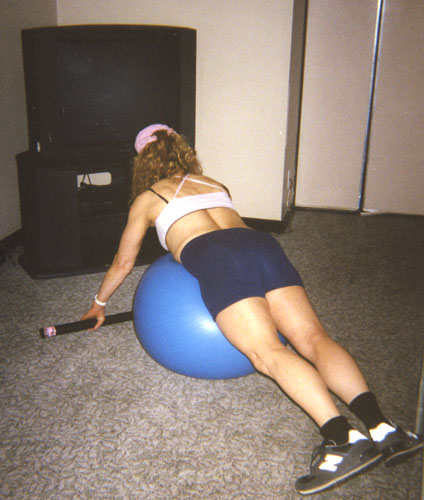
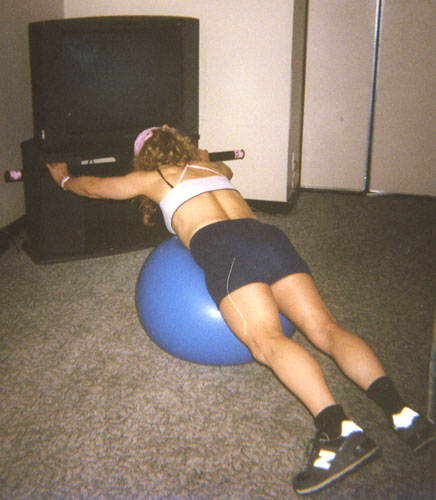 Try adding rows with the bar to your back extensions.
Try adding rows with the bar to your back extensions. 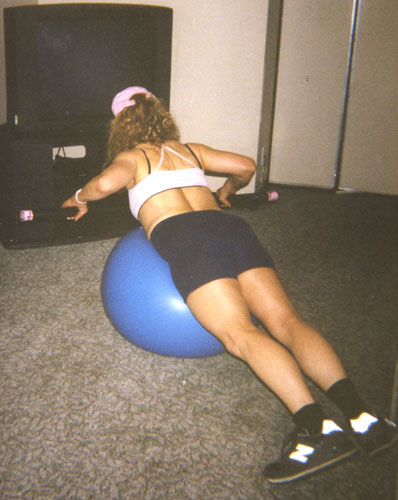
Because the hands are closer together with the ball, it can be hard if you have problems with your shoulders. Otherwise, you can rotate further than with the bar. You can also do plyo with the ball, throwing it when you lie back and reaching up to catch it as you contract your abs.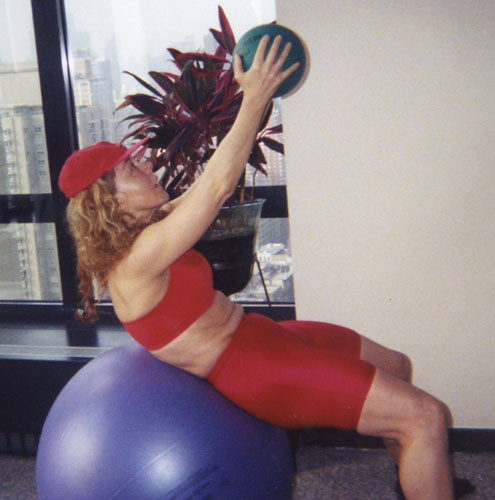
Touch and Twist: Show Some Grist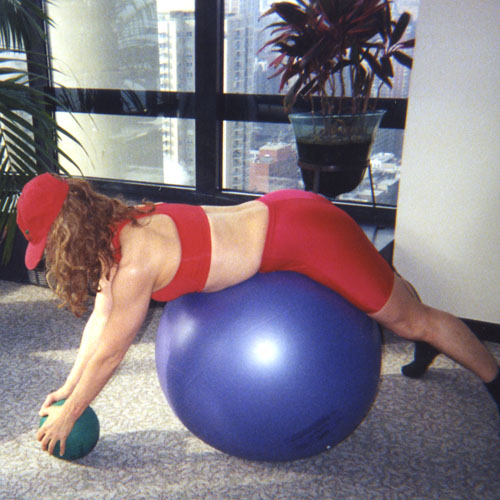
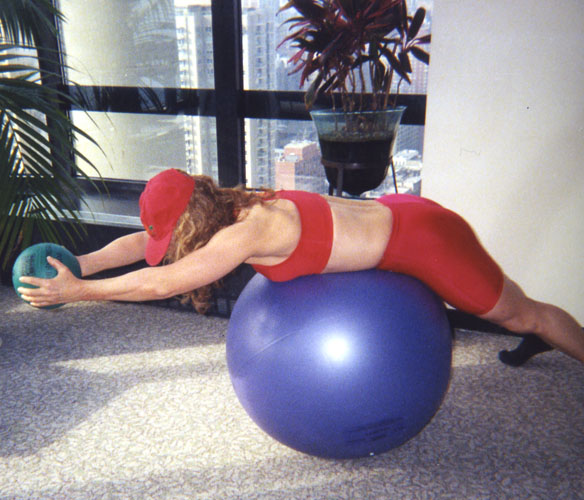 t
t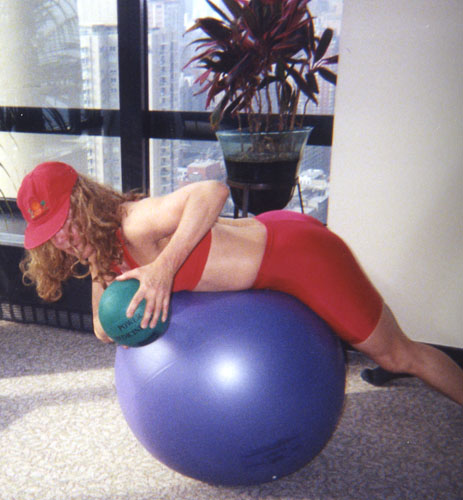 Don't twist if you have posterior osteophytes, spondylolisthesis, or stress fractures.
Don't twist if you have posterior osteophytes, spondylolisthesis, or stress fractures.
Chapter 04: Bounce and BOSU for Bubble Bums, not Buttery Buns
Tighten the tush and improve balance with kicks, lunges, and squats on the Bosu.
Or balance and jump on the trampoline. This is a high-intensity aerobic interval.
Bubble Bums, not Buttery Buns, as You Buttress Your Back Thigh Lifts
Prone on the Step
Cat’s Cradle
Standing
Pelvic Tilts on the Ball or Bosu
Squat on the BOSU Balance Trainer. Put feet slightly forward of center. Bend your knees and push your buttocks back as if you were sitting in a chair. Look forward and keep your torso straight. Lower until your body forms a right angle, and squeeze your buttocks to return to the standing position. Balance on one leg. Once you feel comfortable, move the leg front, side, and back. Planks
Turn the BOSU so the platform is up and hold on to the widest portion, chest directly over middle.
The balls of your feet are on the floor, your torso parallel to the floor with the abs, buttocks, and back contracted. If this is too hard put your knees on the floor. While you are in this position, tilt the BOSU forward and then back without releasing your core muscles. From the plank position, bend your arms and lower your chest to the BOSU.
Get on all fours with your knees evenly spaced on top of BOSU and your
hands on the ground. Lift opposite arm and leg, touching the floor lightly until you have the balance to lift them.
Side Lunge
Do a side lunge with your right foot on the center of the ball and your left foot on the floor and the left arm in a cross punch. Bring the left foot up to the BOSU and switch legs so that the right foot goes to the floor in a side lunge on the other side. For high impact, jump up and swithc so that the other foot lands in the middle of the BOSU and the other foot lunges almost simultaneously. Increase speed as desired. Lunges can be done on the diagonal in a V configuration or back, just like you do in step aerobics.Thigh Lifts and Coccyx Balance
Sit on the middle of the BOSU, with your hands on the floor for support, knees bent, feet flat.
1) Exhale and contract abs as you lift one thigh and replace it.
2) Then try lifting both thighs.
3) Balance on the BOSU in a coccyx balance moving the legs for more challenge.
4) Lift your legs up into a V and lean torso back, keeping back straight and abs contracted. Put your hands behind your head, in front, or straight behind you in a perfect V. When you can do this you have great core stability!Side Sit-ups
Lie sideways on the ball, hips in the middle, and your hand on the floor for support. Contracts love handles and lift legs off floor. Once you get your balance, lift your lower arm off the floor.
Do side crunches coming up and down. Squats With or Without Resistance
Lunges and Lifts
A combo of step--basics, turns, leg lifts and lunges, squats and lifts, standing on the Bosu and lifting weights either in a squat or on one leg with the other lightly touching the side. You can do squat thrusts, push-ups and dips on the Bosu and plyos with one foot on, one foot off, or jumping up and jumping off the Bosu. Sit-ups, Side lifts, planks and spinal extensions are like the Stability Ball. You can also do a coccyx balance on the Bosu. You can also do a few kicks on the Bosu, side, front or back. Then keep the heart rate up with jacks on the floor or little jumps on the Bosu. Light weights or a body bar could be used for more strength. Make sure the grip of the Bosu is solid on the floor. Then use the thigh squeezer between the knees for floor sit-ups. Also do ROM legs with crunches on the floor.
Do planks, pikes and push-ups with the balls of the feet on the Bosu. Rest the forearms on a mat with the balls of the feet on the Bosu. Keep the torso parallel to the floor as you contract you abs, back, and buttocks. Open the palms and place the flat hands under the shoulders, keeping the balls of the feet of the Bosu. Lower and raise the chest to the floor by bending and straightening the arms, letting the elbows go to the side.
Pikes
From the push-up position, Jackknife the torso to lift the buttocks to the ceiling so the body forms a V. Do push-ups and dips and squat thrusts with the hands on the Bosu. Hold the plank position as you use the Gliders.
The only weight lifting that should be done on the Bosu is the light weight series.
Open and Close Elbows against Ribs
Bending Over and Upright
The Parasol
Lateral raises with rotation
Open the Door at 90 degrees
Horizontal bicep curls
Flat Back Straight Arm Series
Rear raises with straight arms overhead
At shoulder level
By the sides
Scarecrow, the Seat Belt and the Veil Wrist curls
Wrist flexors
Wrist extensors
Supination/pronation
Here is where you can do step routines, kicks, lunges, lifts and squat on the Bosu as well as prone-lying extension and buttock exercises.
Push-ups, presses, pikes for perfect pecs and six-pack abs. 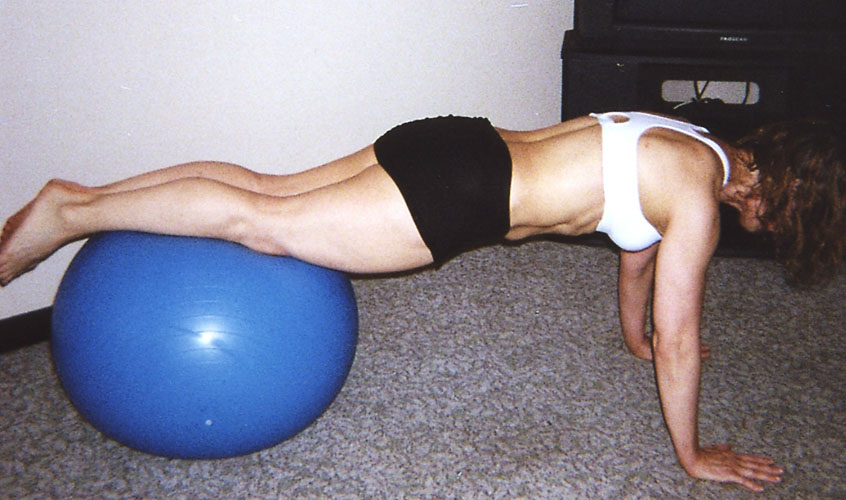
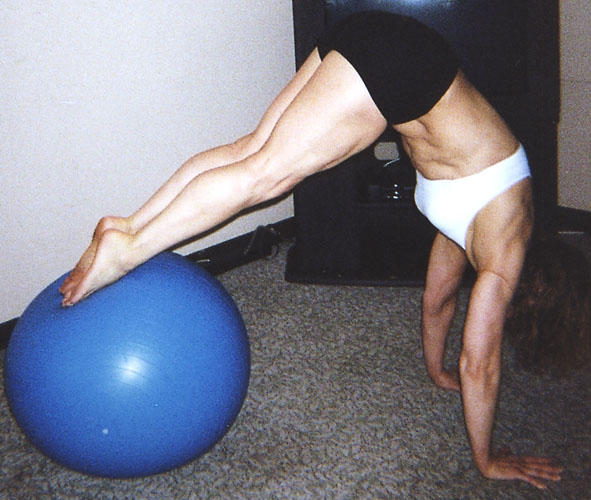 The pike really targets the lower fibers of the abs, especially if you do it with one leg.
The pike really targets the lower fibers of the abs, especially if you do it with one leg. 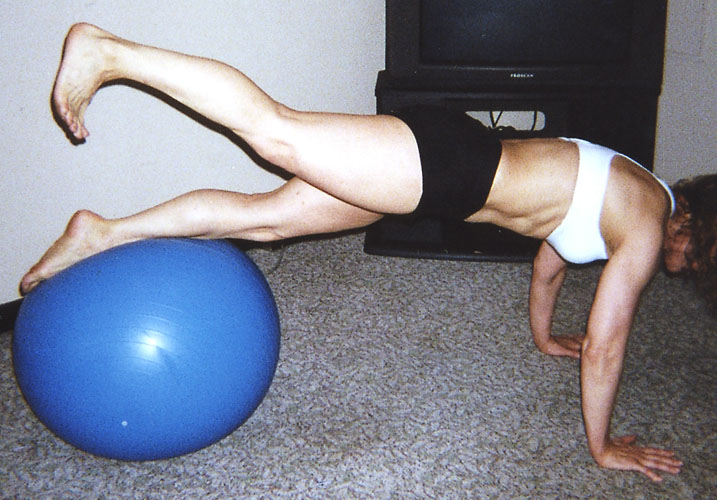 You also have to use your arms and chest to balance as you push into the pike.
You also have to use your arms and chest to balance as you push into the pike. 
I’ve fallen and I can get up could be done with crossed legs, hands in prayer position before a body bar is used. Resistive equipment here can be weights or the Dynaband.
Chapter 06: SEX (or just preparation for it): Wrestle and Release
Scissorholds or Thigh Squeezer? Tighten inner thighs and then stretch legs in all directions using abs to stabilize.
Pain
Don’t twist, turn and yearn when you have back problems. Always warm up with simple isolations and abdominals first.
The Healthy Knockout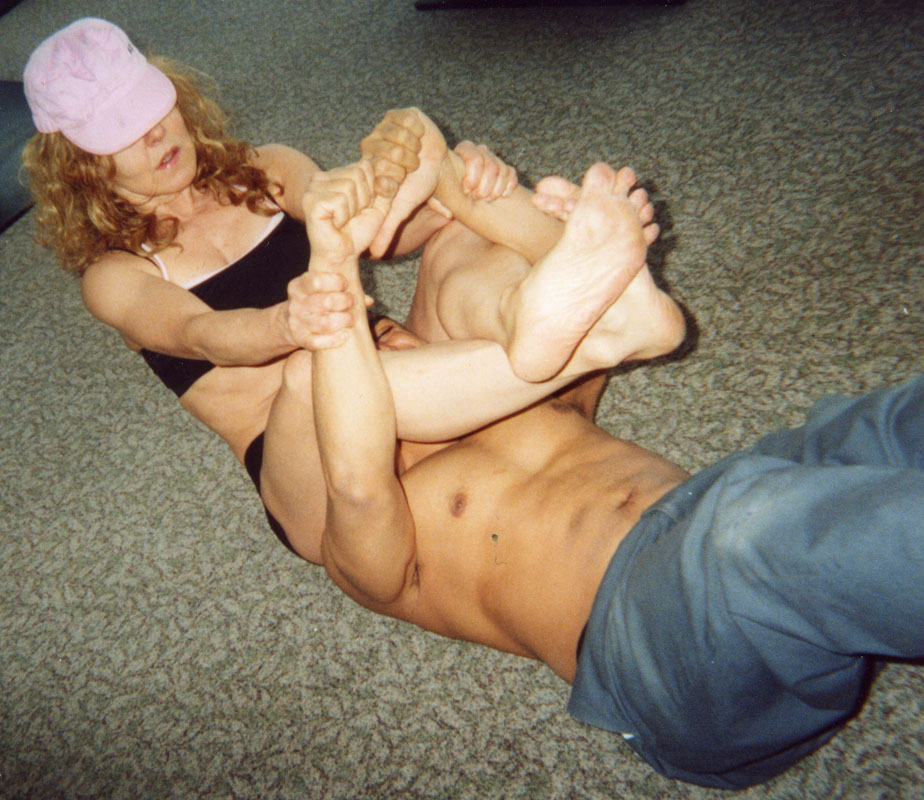
For fifteen years, my wrestling coach began our sessions with
this statement, "Movement is a gift and a privilege, so if you really hurt each other, you will be fired." At the time I didn't appreciate his technique because I was focusing on the $300 an hour that enabled me to keep teaching in college for baby sitter’s wages. But he was so wise. He went to the dance studios to find the most flexible, strongest people he could and then trained them slowly and patiently. I only wrestled men 5’7” to 5’10”, and yes, I had to catch, carry, jerk, throw, mount, nail, and scissor them but I never received so much as a scratch or torn muscle. I scissored to the threshold of pain, then backed off, squeezing my outer thighs harder to make it look worse than it felt. By moaning and screaming, the wrestlers and the eventual viewer had a catharsis that didn't destroy the way our gladiator sports do. This is the healthy knockout.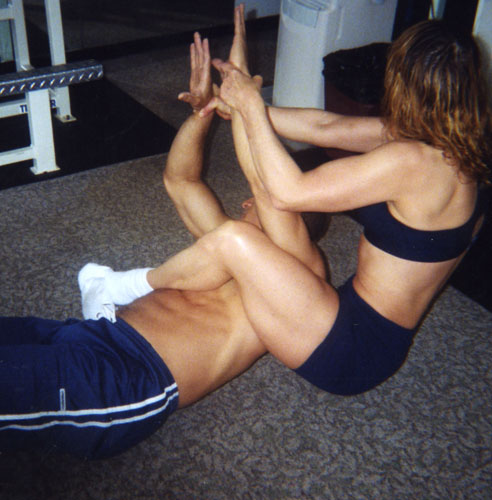 Think about the difference between Shakespeare and Reality TV. Shakespeare has more violence and sex in his plays than any contemporary writer but it is couched in beautiful poetry with actions that aren't too graphic. Everyone has a catharsis but no one is hurt. The true knockout. Perhaps you get your focus sharpened and your rocks off fighting, and surely it is a wonderful sport when limits are placed on it. I will also offer the following medical advice without any attempt to hit on you personally, dear Reaader: if you pitch your sex life to higher decibels you can
Think about the difference between Shakespeare and Reality TV. Shakespeare has more violence and sex in his plays than any contemporary writer but it is couched in beautiful poetry with actions that aren't too graphic. Everyone has a catharsis but no one is hurt. The true knockout. Perhaps you get your focus sharpened and your rocks off fighting, and surely it is a wonderful sport when limits are placed on it. I will also offer the following medical advice without any attempt to hit on you personally, dear Reaader: if you pitch your sex life to higher decibels you can
also have a knockout, although martial arts lovemaking requires an ability to distinguish play from real harm. If a known serial killer knocks on your door, feel free to risk your life knocking him out, but if movement is a gift and a privilege, so honor it, especially when you are training. 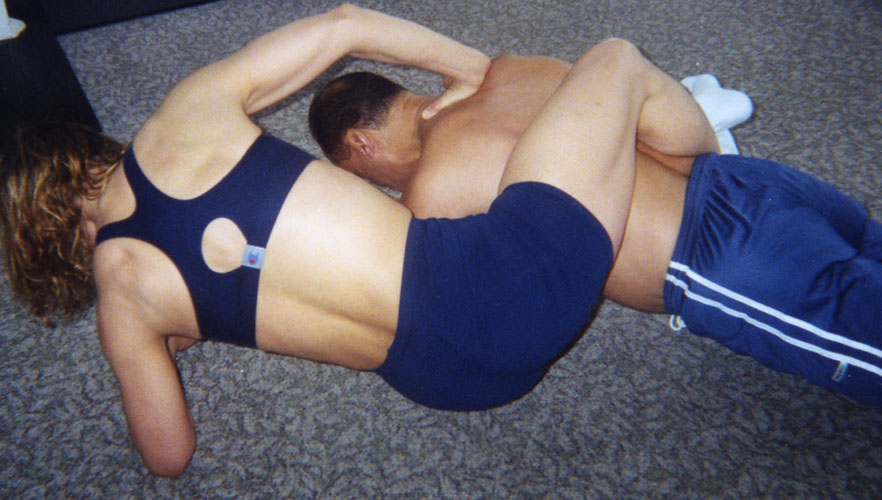 In order to keep training, wrestling holds are held from 5-30 seconds, intensifying the squeeze as tolerated. You don't have to be a wrestler to practice a few moves every session for cross-training. If you are interested in wrestling or MMA, obviously your work will be more advanced.
In order to keep training, wrestling holds are held from 5-30 seconds, intensifying the squeeze as tolerated. You don't have to be a wrestler to practice a few moves every session for cross-training. If you are interested in wrestling or MMA, obviously your work will be more advanced.
Schoolboy Pin
Cobra Clutch
Camel Clutch
Crossface
Figure
Body Scissors
Head Scissors
Full Nelson
Half Nelson
Fish Hook
Bow and Arrow Hold
Indian Deathlock
Damascus Head Leglock
Sequences
1) Begin Aerobic Gut and Butt on the BOSU for isolations and belly dance.
2) Crunch and punch in all directions.
3) Then do bar chops standing with rotation, and dead lifts on the BOSU with the bar.
4) Do side and front planks off the BOSU.
5) Turn the BOSU over and use it as a BAPS board to strengthen the intrinsic muscles of the feet by circling in all directions.Do aerobic leg lifts front, side and back on the Bosu. Kneel on the Bosu and lift weights.
6) Squeeze and release.